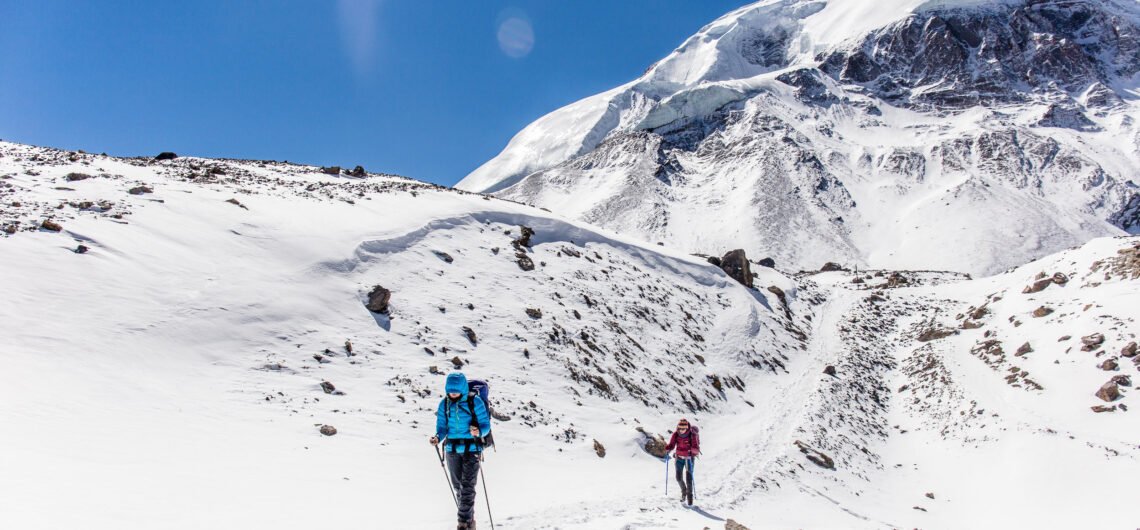Thorong La Pass, Nepal. Nestled high in the Annapurna mountain range, Thorong La Pass stands as one of the highest trekking passes in the world, sitting at an awe-inspiring altitude of 5,416 meters (17,769 feet). This remarkable destination offers trekkers an unparalleled experience of natural beauty, cultural richness, and a sense of adventure that is truly unmatched.
A Brief History of Thorong La Pass
Thorong La Pass has long been a critical crossing point for traders and pilgrims traveling between the Annapurna and Mustang regions. Historically, it served as a vital link for the local people, fostering trade and cultural exchanges between the distinct communities. Over the years, it has gained immense popularity among trekkers from all over the globe, thanks to its challenging terrain, stunning landscapes, and the sense of accomplishment that comes with conquering one of the highest passes on Earth.
Detailed Itinerary for Thorong La Pass Trek
Day 1: Arrival in Kathmandu
Your adventure begins in Kathmandu, the bustling capital of Nepal. Spend the day exploring the city’s vibrant streets, ancient temples, and bustling markets. Don’t forget to visit the UNESCO World Heritage Sites like Swayambhunath (Monkey Temple) and Pashupatinath Temple.
Day 2: Drive to Besishahar and Trek to Bhulbhule
A scenic drive takes you to Besishahar, the starting point of the Annapurna Circuit Trek. From here, you will begin your trek to Bhulbhule, enjoying the lush green landscapes and the sound of the Marsyangdi River.
Day 3: Bhulbhule to Chamje
Today’s trek involves walking through terraced fields, quaint villages, and dense forests. You’ll cross suspension bridges and climb gradually to the village of Chamje.
Day 4: Chamje to Bagarchhap
The trail continues through rocky landscapes and along the riverbank, passing through the village of Tal. After ascending through forests of pine and fir, you’ll reach Bagarchhap, a traditional Tibetan village.
Day 5: Bagarchhap to Chame
As you trek towards Chame, the district headquarters of Manang, you’ll be greeted by stunning views of Annapurna II and Lamjung Himal. The trail winds through forests and along steep ridges.
Day 6: Chame to Pisang
Today’s trek offers a dramatic change in the landscape. You’ll traverse through a narrow and steep-sided valley, which eventually opens up to the majestic view of the Pisang peak and the surrounding mountains.
Day 7: Pisang to Manang
The trek to Manang is characterized by the arid landscape and stunning views of the Annapurna range. Manang is a vibrant town where you can explore local culture and prepare for the higher altitudes ahead.
Day 8: Acclimatization Day in Manang
To adjust to the altitude, you’ll spend an extra day in Manang. You can take short hikes to the surrounding areas like Gangapurna Lake or visit the local monastery.
Day 9: Manang to Yak Kharka
Ascending further, you’ll trek to Yak Kharka. The landscape becomes more barren, and you’ll start to feel the effects of the altitude. Yak Kharka is a small settlement, primarily used by trekkers for acclimatization.
Day 10: Yak Kharka to Thorong Phedi
The trek continues to Thorong Phedi, the base camp for the Thorong La Pass. This is a short yet strenuous trek, preparing you for the big climb the next day.
Day 11: Cross Thorong La Pass to Muktinath
This particular day presents trekkers with the ultimate test of endurance, but also promises unparalleled satisfaction and a sense of accomplishment upon completion. You’ll start early to cross Thorong La Pass, reaching the summit where prayer flags flutter in the wind. The descent into Muktinath is steep and long, but the sense of achievement is exhilarating.
Day 12: Muktinath to Jomsom
Muktinath is a revered destination for pilgrims of both Hindu and Buddhist faiths. After visiting the temple, you’ll trek to Jomsom, enjoying the change in scenery as you descend into the Kali Gandaki Valley.
Day 13: Flight from Jomsom to Pokhara
A short but scenic flight takes you from Jomsom to Pokhara. Relax in this beautiful lakeside city, exploring its cafes, shops, and the serene Phewa Lake.
Day 14: Return to Kathmandu
Drive or fly back to Kathmandu, where you can spend your last day shopping for souvenirs or exploring more of the city’s cultural treasures.
FAQs about Thorong La Pass Trek
Q1: When is the best time to trek Thorong La Pass?
The best time to trek Thorong La Pass is during the pre-monsoon (March to May) and post-monsoon (September to November) seasons. The weather is stable, and the views are spectacular during these periods.
Q2: Do I need a permit to trek Thorong La Pass?
Yes, trekkers need the Annapurna Conservation Area Permit (ACAP) and the Trekkers’ Information Management System (TIMS) card to trek in this region.
Q3: How difficult is the trek to Thorong La Pass?
The trek is considered challenging due to the high altitude and rugged terrain. Proper acclimatization, physical fitness, and preparation are crucial for a successful trek.
Q4: What kind of accommodation is available on the trek?
Along the trekking route, travelers can find a variety of teahouses and lodges offering simple yet comfortable lodging options and delicious meals to refuel for the journey ahead. They are comfortable but can be quite basic, especially at higher altitudes.
Embarking on the Thorong La Pass trek is an adventure of a lifetime, offering breathtaking scenery, rich cultural experiences, and the thrill of crossing one of the world’s highest trekking passes. Prepare well, respect the mountains, and enjoy every moment of this incredible journey.
Nepal Gov Official Site to Get Permission for Trek and Other Related Formalities —> https://ntb.gov.np/
